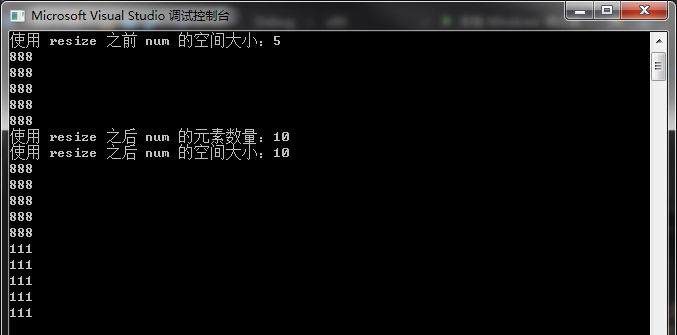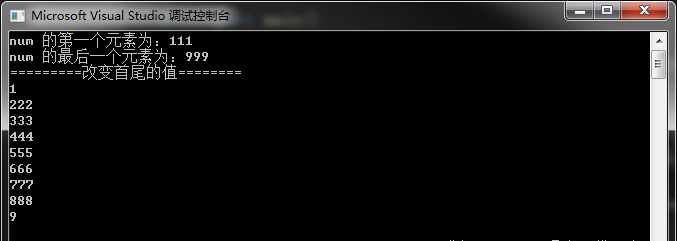STL—— 容器(vector)的各种功能方法
1. 获取容器的元素个数 size()
使用 vectorName.size() 可以输出这个容器中类型的个数,如下代码:
1 #include <iostream> 2 #include <vector> 3 4 using namespace std; 5 6 int main() 7 { 8 vector<int>num(3, 111); 9 cout << "num 的元素个数:" << num.size() << endl; 10 11 return 0; 12 }
打印结果:

2. 获取容器的大小 capacity()
使用 vectorName.capacity() 可以输出这个容器分配了多少个元素的内存空间,如下代码:
1 #include <iostream> 2 #include <vector> 3 4 using namespace std; 5 6 int main() 7 { 8 vector<int>num(5, 111); 9 cout << "num 容器的大小:" << num.capacity() << endl; 10 11 return 0; 12 }
打印结果:

3. vector 容器是否为空 empty()
使用 vectorName.empty() 方法可以获取容器是否为空,如果为空将会返回 true ,否则返回false,如下:
1 #include <iostream> 2 #include <vector> 3 4 using namespace std; 5 6 int main() 7 { 8 vector<int>num; 9 10 if (num.empty()) 11 { 12 cout << "容器 num 为空" << endl; 13 } 14 15 return 0; 16 }
打印结果:

4. 重新调整 vector 的大小: resize()
缩小:使用 vectorName.resize() 可以重新分配 vector 的大小,重新分配后 vector 的元素个数将会改变,但是容器的大小不会改变,如下代码:
1 #include <iostream> 2 #include <vector> 3 4 using namespace std; 5 6 int main() 7 { 8 vector<int>num(5, 888); 9 10 printf("使用 resize 之前\n"); 11 cout << "使用 resize 之前 num 的元素数量:" << num.size() << endl; 12 cout << "使用 resize 之前 num 的空间大小:" << num.capacity() << endl; 13 14 for (int i = 0; i < num.size(); i++) 15 { 16 cout << num[i] << endl; 17 } 18 19 num.resize(2); 20 21 cout << "使用 resize 之后 num 的元素数量:" << num.size() << endl; 22 cout << "使用 resize 之后 num 的空间大小:" << num.capacity() << endl; 23 for (int i = 0; i < num.size(); i++) 24 { 25 cout << num[i] << endl; 26 } 27 28 return 0; 29 }
打印结果:

增加:上边是将 vector 的容量缩小,resize() 的另一种用法可以将 vector 扩容,如下:
1 #include <iostream> 2 #include <vector> 3 4 using namespace std; 5 6 int main() 7 { 8 vector<int>num(5, 888); 9 10 printf("使用 resize 之前\n"); 11 cout << "使用 resize 之前 num 的元素数量:" << num.size() << endl; 12 cout << "使用 resize 之前 num 的空间大小:" << num.capacity() << endl; 13 14 for (int i = 0; i < num.size(); i++) 15 { 16 cout << num[i] << endl; 17 } 18 19 num.resize(10, 111); //可以将 vector 扩容,将5变为10,并且将新扩展的元素初始化为 111,如果不写 111 会将新增加的元素初始化为 0 20 21 cout << "使用 resize 之后 num 的元素数量:" << num.size() << endl; 22 cout << "使用 resize 之后 num 的空间大小:" << num.capacity() << endl; 23 for (int i = 0; i < num.size(); i++) 24 { 25 cout << num[i] << endl; 26 } 27 28 return 0; 29 }
打印结果:

5. 获取&修改 vector 容器的第一个和最后一个元素的值 front() 和 back()
获取:使用 vectorName.front() 与 vectorName.back() 来获取 vector 的第一个元素与最后一个元素的引用,如下代码:
1 #include <iostream> 2 #include <vector> 3 4 using namespace std; 5 6 int main() 7 { 8 int test[] = { 111,222,333,444,555,666,777,888,999 }; 9 vector<int>num(test, test + 9); 10 11 cout << "num 的第一个元素为:" << num.front() << endl; 12 cout << "num 的最后一个元素为:" << num.back() << endl; 13 14 return 0; 15 }
打印结果:

修改:因为返回的是其引用,那么我们也可以进行赋值操作,如下代码:
1 #include <iostream> 2 #include <vector> 3 4 using namespace std; 5 6 int main() 7 { 8 int test[] = { 111,222,333,444,555,666,777,888,999 }; 9 vector<int>num(test, test + 9); 10 11 cout << "num 的第一个元素为:" << num.front() << endl; 12 cout << "num 的最后一个元素为:" << num.back() << endl; 13 14 cout << "=========改变首尾的值========" << endl; 15 num.front() = 1; 16 num.back() = 9; 17 18 for (int i = 0; i < num.size(); i++) 19 { 20 cout << num.at(i) << endl; 21 } 22 23 return 0; 24 }
打印结果:

=========================================================================================================================


